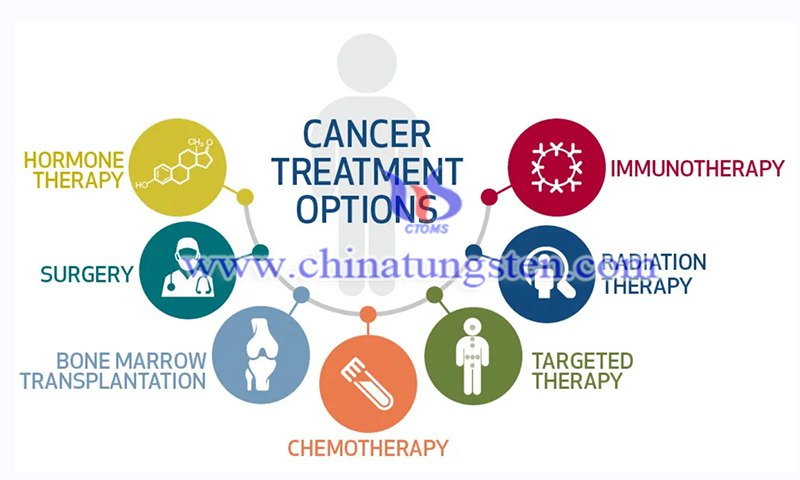Application of Tungsten Disulfide Nanomaterials in Cancer Therapy
- Details
- Category: Tungsten Information
- Published on Wednesday, 17 August 2022 23:17
In recent years, tungsten disulfide nanomaterials (WS2NM) have had important applications in cancer therapy. Researchers have synthesized chitosan-functionalized WS2 nanocomposites (CS/ WS2/Ru) implanted with ruthenium nanoparticles. Chitosan is biocompatible and non-toxic, making it an excellent candidate for drug delivery systems. On the other hand, the biological properties of chitosan can be improved due to the small size and large surface area of WS2.
Due to its toxicity against fungi, bacteria, and viruses, Ru is a good choice for the development of anti-pathogenic drugs. The cytotoxicity of CS/ WS2/Ru nanoparticles at different concentrations on Vero cells was studied in vitro. The results showed minimal and negligible toxicity. The antimicrobial activity was studied against Bacillus subtilis, Staphylococcus aureus Gram (+), and K. pneumoniae, Escherichia coli Gram (-) bacterial groups with different concentrations of nanocomposites.

(Picture source: Houston Methodist)
The results suggest that oxidative stress generated by chitosan-functionalized tungsten disulfide nanomaterials plays an important role in the antibacterial activity. It was observed that Ru enters the cytoplasm and interacts with proteins and DNA, leading to cell death. MCF-7 breast cancer cell line was selected to study the anticancer activity of different concentrations of CS/ WS2/Ru versus control.
Higher cytostatic effects were shown in CS/ WS2/Ru nanocomposites at 100 μg/ml. W4+ and Ru4+ positive charges play a role in the disruption of cell membranes and mitochondrial dysfunction, ROS production, and oxidative stress as pathways of cytotoxic effects in cancer cells, demonstrating the anticancer activity of the composites.
In another study, the researchers used CS/ WS2/Pd to investigate the antibacterial and anticancer activity. The bacterial groups and cancer cell lines subjected to the nanoparticles were the same as in their previous study. CS/ WS2/Pd nanostructures were tested for antibacterial activity against Gram (+) and Gram (-) bacterial groups and the zone of inhibition was evaluated at a concentration of 100 μg/ml. The maximum inhibition was observed against E. coli. In vitro cytotoxicity was evaluated against Vero cells at different concentrations and showed negligible toxicity.
In addition, the inhibition of MCF7 cancer cells was 70.15% and 73.24% in 100 μg/ml of CS/ WS2 and CS/ WS2/Pd nanomaterials, respectively. The results indicate that W4+ and Pd+ positive charges effectively attach to negatively charged cell membranes and play a destructive role on them.

(Picture source: Houston Methodist)
The anticancer activity of WS2 nanosheets against lung cancer cells was also investigated. WS2 nanoparticles showed no signs of toxicity to cancer cells on the first day of the incubation period, but extending this time to 2 days resulted in a concentration-dependent decrease in cell viability, with a maximum cytotoxic effect at nearly 2 μg/mL of WS2, due to a longer time to enter tumor cells or accumulate on their surface.
In summary, WS2 nanomaterials and related nanocomposites are biocompatible and could be an important approach for use in biosensors, bioimaging, dental and orthopedic implants, controlled drug delivery, tissue engineering, cancer therapy, photothermal and radiation therapy.
Tungsten nanomaterials are the solution to overcome many problems in the medical and pharmaceutical fields in the future due to their unique properties in chemical-physical structure, optics, and electricity. Understanding the fundamentals of WS2 nanomaterials and their interactions with biomolecules and cells or organs, as well as the functionalization of WS2NM by biomolecules, can help researchers and medical practitioners to develop new nanostructures and nanocomposites that will be applicable to nanomedicine in the future.
Niknam S., Ahmad Dehdast S., Pourdakan O., Shabani M., Kazem Koohi M. Tungsten Disulfide Nanomaterials (WS2NM) Application in Biosensors and Nanomedicine, A review. Nanomed Res J, 2022; 7(3): 214-226. DOI: 10.22034/nmrj.2022.03.001
- Tungsten Manufacturer & Supplier, Chinatungsten Online: www.chinatungsten.com
- Tungsten News & Prices of China Tungsten Industry Association: www.ctia.com.cn
- Molybdenum News & Price: news.molybdenum.com.cn
- Tel.: 86 592 5129696; Fax: 86 592 5129797; Email: sales@chinatungsten.com



 sales@chinatungsten.com
sales@chinatungsten.com